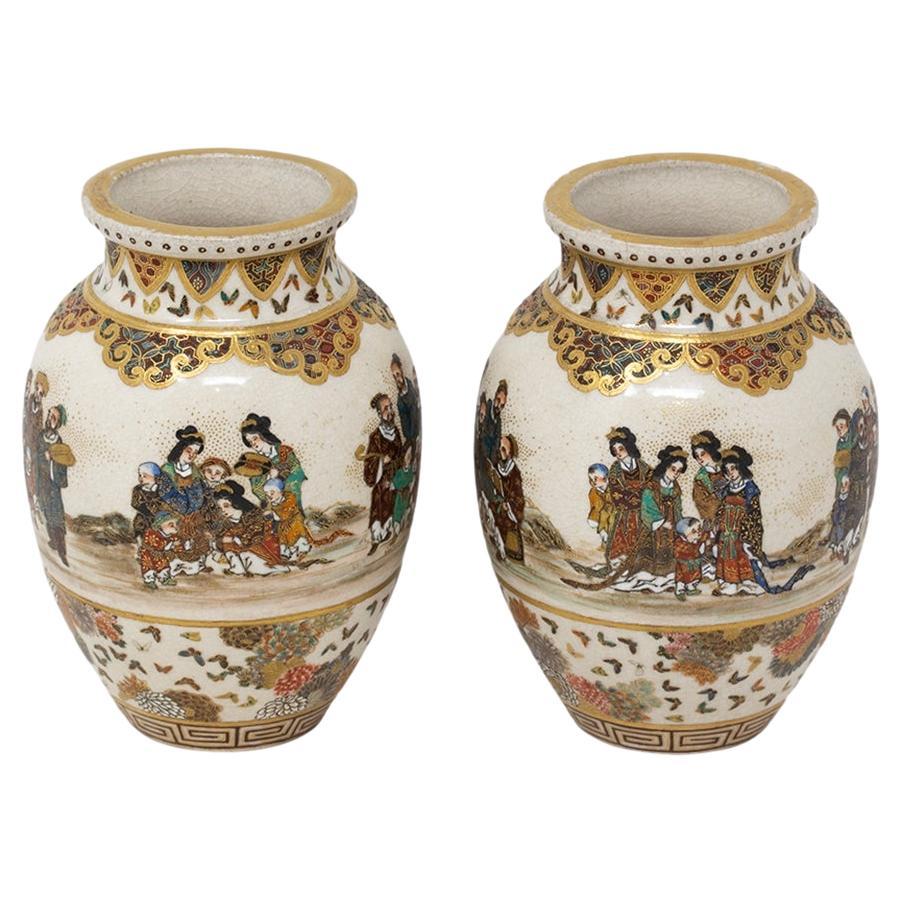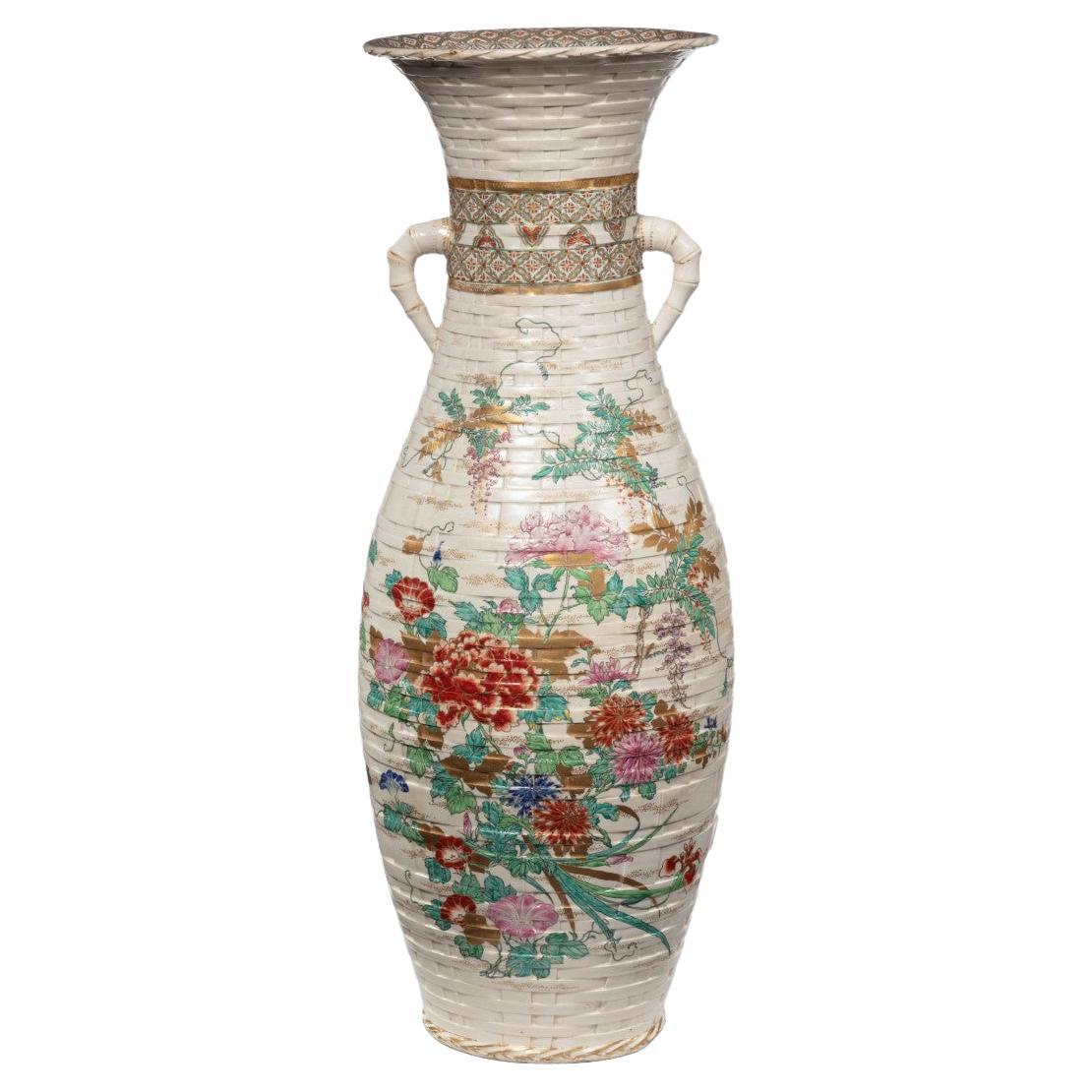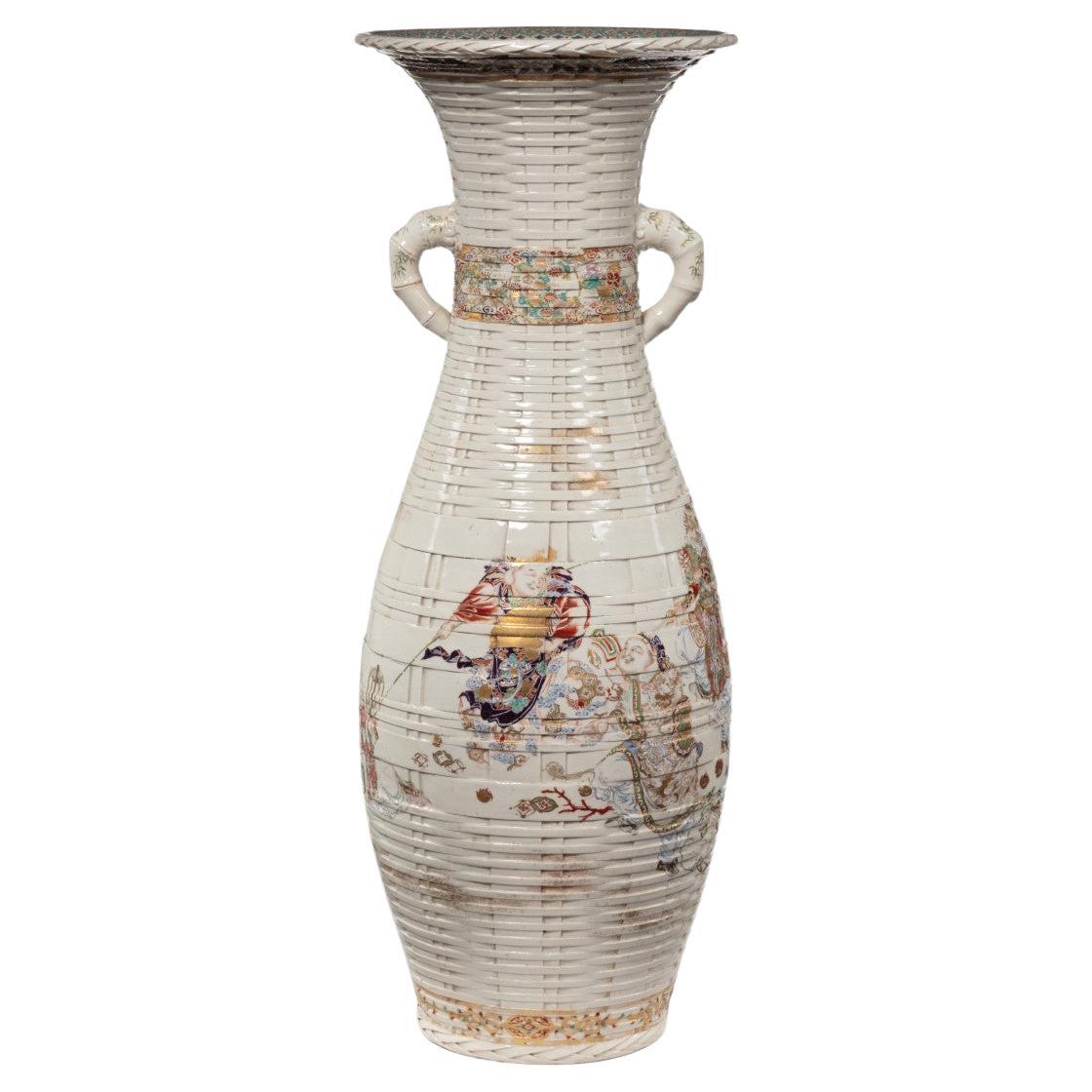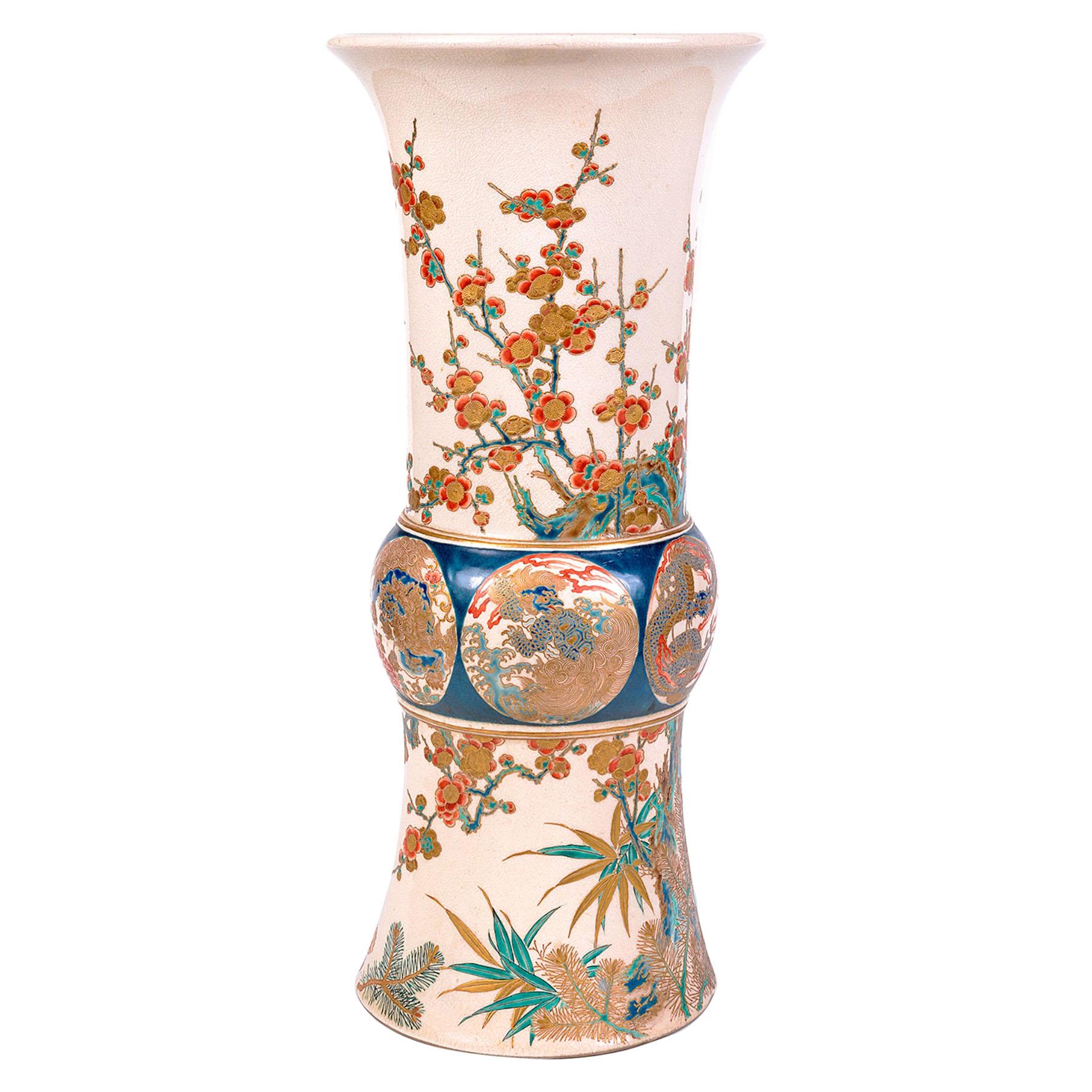Items Similar to Japanese Meiji Period Satsuma Floor Vases
Want more images or videos?
Request additional images or videos from the seller
1 of 21
Japanese Meiji Period Satsuma Floor Vases
About the Item
The vases of large oval form potted from earthenware with pinched neck and base stood upon a splayed circular foot. The vases extensively decorated with a continuous scene with polychrome colours and raised enamels featuring a large central white elephant and various figures. The top and bottom bordered by arched gilt decoration and gilded rims. The bases signed by a three character mark in red 新井造 Arai Zo (made by Arai). The vases date to the Meiji period (1868-1912) and are large in size measuring 46cm High.
Meiji Period is an era of Japanese history that spanned from 1868 to 1912. It was the first half of the Empire of Japan, when the Japanese people began to build a paradigm of a modern, industrialised nation state and emergent great power, influenced by Western countries and aesthetics. As a result of radically different ideas, the changes to Japan were profound and it affected the social structure, politics, economy, military, and foreign relations across the board. The period corresponded to the reign of Emperor Meiji and was preceded by the Keio era and was succeeded by the Taisho era.
Cultural Art during the Meiji Period was of particular interest to the government and they overhauled the art export market which in turn promoted Japanese arts via various world’s fairs, beginning in Vienna at the world fair in 1873. The government heavily funded the fairs and took an active role organising how Japan’s culture was presented to the world including creating a semi-public company named Kiritsu Kosho Kaisha (First Industrial Manufacturing Company). The Kiritsu Kosho Kaisha was used to promote and commercialise exports of Japanese art and established the Hakurankai Jimukyoku (Exhibition Bureau) to maintain quality standards. For the 1876 Centennial International Exhibition in Philadelphia, the Japanese government created a Centennial Office and sent a special envoy to secure space for the 30,000 items that would be displayed. The Imperial Household also took an active interest in arts and crafts, commissioning works by select artists to be given as gifts for foreign dignitaries further emphasising the high quality and importance of Japanese art. Just before the end of the 19th century in 1890, the Teishitsu Gigeiin (Artist to the Imperial Household) system was created to recognise distinguished artists. These artists were selected for their exceptionally high quality wares and talent in their own industry. Over a period of 54 years Seventy artists were appointed, amongst these were ceramicist Makuzu Kozan and cloisonné enamel artist Namikawa Yasuyuki.
Earthenware is glazed or unglazed non-vitreous (absorbs water) pottery that has normally been fired below 1,200 °C (2,190 °F). Basic earthenware is also known as terracotta and it absorbs liquids such as water.
Polychrome refers to the practice of decorating objects in a variety of colours.
Measurements 46cm High x 30cm
- Dimensions:Height: 18.1 in (45.98 cm)Diameter: 11.8 in (29.98 cm)
- Style:Meiji (Of the Period)
- Materials and Techniques:
- Place of Origin:
- Period:
- Date of Manufacture:Circa 1890
- Condition:Wear consistent with age and use.
- Seller Location:Newark, GB
- Reference Number:
About the Seller
5.0
Vetted Seller
These experienced sellers undergo a comprehensive evaluation by our team of in-house experts.
Established in 2019
1stDibs seller since 2022
17 sales on 1stDibs
Typical response time: 3 hours
- ShippingRetrieving quote...Ships From: Newark, United Kingdom
- Return PolicyA return for this item may be initiated within 14 days of delivery.
More From This SellerView All
- Japanese Meiji Period Satsuma Vase Pair GyokuzanLocated in Newark, EnglandPainted with Continuous Scenes From our Japanese collection, we are delighted to offer this Japanese Satsuma Vase Pair by Gyokuzan. The vases of squat bulbous form with pinched neck...Category
Antique Late 19th Century Japanese Meiji Vases
MaterialsCeramic, Pottery, Earthenware
- Japanese Bronze Vase Pair Meiji PeriodLocated in Newark, EnglandA fine large sized pair of Japanese bronze vases. The vases each surmounted by waisted necks flanked by two spreading handles with accents in the form of Japanese Torri (traditional ...Category
Antique Late 19th Century Japanese Meiji Metalwork
MaterialsMetal, Gold, Silver, Bronze, Copper
- Japanese Hand Painted Meiji Period Satsuma VaseBy KinkozanLocated in Newark, EnglandSquat Bulbous Form From our Japanese collection, we are delighted to offer this Japanese Meiji Period Satsuma Vase. The Satsuma vase of squat bulbous form with a tightly pinched nec...Category
Antique Late 19th Century Japanese Meiji Ceramics
MaterialsCeramic, Earthenware, Pottery
- Japanese Meiji Period Satsuma Vase by KinkozanBy KinkozanLocated in Newark, EnglandThe vase is potted in globular form with a tightly pinched neck and rolled top rim beautifully decorated with four highly detailed individual panelled scenes. The first a Geisha bari...Category
Antique Late 19th Century Japanese Meiji Ceramics
MaterialsCeramic, Earthenware, Pottery
- Japanese Cloisonne Enamel Vase Pair Meiji PeriodLocated in Newark, EnglandA sensational pair of Japanese Meiji period Cloisonne enamel bottle vases. The vases of slender hexagonal form with trumpet opening upon a circular foot. Decorated to the highest qua...Category
Antique Late 19th Century Japanese Meiji Metalwork
MaterialsMetal, Silver
- Japanese Meiji Period Satsuma Bowl KinkozanBy KinkozanLocated in Newark, EnglandFrom our Japanese collection, we are delighted to offer this Japanese Meiji period Satsuma Bowl by Kinkozan. The earthenware bowl with pinched rim extensively decorated on both the exterior and interior. The bowl with a cobalt blue base glaze decorated to the borders with gilt shippo-tsunagi (linked-cash) with scattered medallion roundells. Around the exterior two elongated scenes are featured, one with boys playing games in a courtyard with the other featuring seated scholars in full dress both with raised enamel decoration. The interior features a central scene with Samurai warriors in training fully armoured with swords in a courtyard with landscapes scenes to the background. The central scene bordered by further stylised shippo-tsunagi type decoration with a greek key rim border. The bowl signed to the base Kinkozan dating to the Meiji Period (1868-1912) circa 1900. Shippo-Tsunagi (linked-cash) or seven treasures, is a traditional Japanese geometric pattern that combines four ellipses in a circle. These ellipses repeat outward to then create more circles, symbolising eternal peace and happiness. Kinkozan the Kinkozan family have been associated with pottery dating back to 1645. They went on to become the largest producer of Satsuma ware by one individual company, from the end of the 19th century until 1927 after which the factory closed. By the 1850s Kobayashi Sobei (1824-84), Kinkozan Sobei...Category
Antique Early 1900s Japanese Meiji Ceramics
MaterialsCeramic, Earthenware, Pottery, Faux Leather
You May Also Like
- Large Meiji Period Satsuma Earthenware Floor VaseLocated in Lymington, HampshireA large Meiji period Satsuma earthenware floor vase, the of baluster form, painted in pastel overglaze enamels and gilding with two large sprays of flowers including prunus blossom, ...Category
Antique 1870s Japanese Meiji Ceramics
MaterialsEnamel
- Large Meiji Period Satsuma Earthenware Floor VaseLocated in Lymington, HampshireA large Meiji period Satsuma earthenware floor vase, the skittle shaped body painted in pastel overglaze enamels and gilding with a continuous frieze of the Seven Gods...Category
Antique 1870s Japanese Meiji Ceramics
MaterialsEnamel
- Meiji period Satsuma vase.By SatsumaLocated in Brighton, SussexA good quality 19th Century Japanese Satsuma vase, having imperial influences with a dark blue ground, blossom tree decoration to the flared neck, circul...Category
Antique Late 19th Century Japanese Vases
MaterialsPorcelain
- Antique Japanese Meiji Satsuma Painted VaseBy SatsumaLocated in LA CIOTAT, FRA petite and beautiful hand-decorated ceramic baluster vase, painted all around with traditional Japanese motifs, including native flora, birds and bamboo stems on a creamy glazed background. The colour palette is bold and bright, with highlights of green, red and blue, together with plentiful gilt relief...Category
Antique 19th Century Japanese Meiji Ceramics
MaterialsCeramic
- Japanese Satsuma Vase Yabu Meizan MeijiBy Yabu MeizanLocated in Atlanta, GAA Satsuma baluster form vase from the studio of Yabu Meizan (birth name Yabu Masashichi; 1853-1934), who is one of the most celebrated and collectible Satsuma artists from Meiji Peri...Category
Early 20th Century Japanese Meiji Ceramics
MaterialsCeramic
- Imperial Japanese Satsuma two handle vase, Meiji period.Located in Brighton, SussexA fine quality Japanese Imperial Satsuma vase, having wonderful hand painted classical decoration of motifs, mythical Dragon handles to either side and an inset panel depicting bloss...Category
Antique Late 19th Century Japanese Vases
MaterialsPorcelain
Recently Viewed
View AllMore Ways To Browse
Antique White Ceramic Elephant
Arts And Crafts Ceramic Pottery Vase
Satsuma Elephant
Painted Terracotta Vase
Japanese Vase Country
Japanese Carved Pottery
Hand Painted Japanese Pottery
Large 19th Century Vase Signed
Red Antique Vases
Richard Ginori Sirio
Royal Crown Derby Ewer
Bubble Art
Blue White Containers
Janos Torok Zsolnay
Pair Vases Tree Flowers
Vases Italy 1960
White Roses Vase
Deco Glass White Vase





